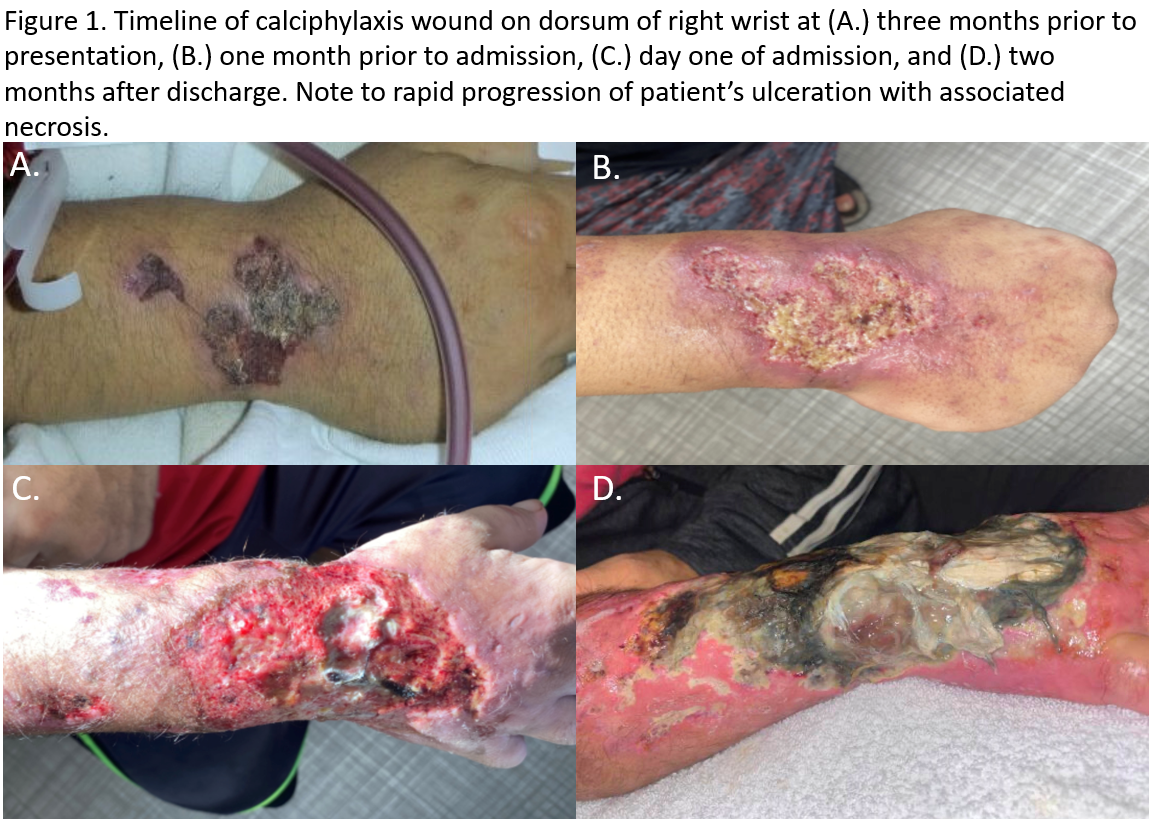Case Presentation: Our patient is a 42-year-old male with history significant for hypertension, end stage renal disease (ESRD) on hemodialysis (HD), anemia of chronic disease, renal osteodystrophy, and right wrist calciphylaxis who presented with worsening right wrist erythema and bleeding. Patient had reported non-compliance with his dialysis schedule and noted to have multiple previous admissions for volume overload secondary to non-adherence to HD. Vitals were significant for a temperature of 101°F. Initial labs showed: white blood cell count 7.2 k/µL, hemoglobin 6.7 g/dL, creatinine 6.43 mg/dL, BUN 24 mg/dL, and calcium 9 mg/dL. Physical examination revealed a worsening right wrist ulceration with necrosis and active bleeding (Figure 1). Patient was started on vancomycin and meropenem for concern of infected calciphylaxis wound and transfused with packed red blood cells. General Surgery, Vascular Surgery, Nephrology, Infectious Disease, and wound care team were consulted. Patient required suture ligation for hemostasis of the wound. Wound cultures showed non-specific rare gram positive cocci and gram negative bacilli. Patient received ten days of vancomycin and ceftazidime prior to discharge home. He was instructed on the importance of adherence to his HD and sodium thiosulfate for his calciphylaxis. Over the next three months, he would continue to have recurrent hospitalizations before ultimately requiring amputation of the right wrist at a tertiary center for osteomyelitis and uncontrolled wound pain.
Discussion: Calciphylaxis is a dermatologic disease associated with end-stage renal disease that presents with ischemic skin lesions.1 The pathogenesis of these lesions are thought to be due to occlusive calcification of the medial layer of arterioles and small arteries leading to ischemia.2 This occurs due to the dysfunction of calcium, phosphate, Vitamin K, and PTH regulation in ESRD patients.2 Classically, calciphylaxis presents with painful ulcerations which preferentially affects areas with adipose tissue such as the thighs and abdomen.3 However, the disease can be manifested with a wide variety of skin lesions including plaques, nodules, erosions, and livedo reticularis.1,2 The skin lesions tend to have significant morbidity/mortality associated with them, especially once they ulcerate and become a source for infection as with our patient.1,3 Annual mortality rates are upwards of 80% generally from sepsis.2 Standard therapy for calciphylaxis is sodium thiosulfate which binds calcium, to be excreted renally or via dialysis, and reactive oxygen species.2,4 Surgical intervention, such as debridement, is reserved for infected wounds and not extensively studied for outcomes such as survival.2,3,5 Due to the multifaceted nature of the disease, a multidisciplinary approach is necessary as with our patient. Wound care is crucial for appropriate dressings of the lesions. Antibiotics and surgical evaluation may be necessary if there is concern for superimposed infection.2 Multimodal pain control in these patients is imperative as the ischemic skin lesions can cause nociceptive, neuropathic, and inflammatory pain.6 Despite this approach for our patient, his severe osteomyelitis and uncontrolled pain necessitated amputation.
Conclusions: Calciphylaxis is a unique skin manifestation of ESRD which can have devastating consequences worsened by non-adherence. This case underlines the need for an interdisciplinary approach in these patients.

